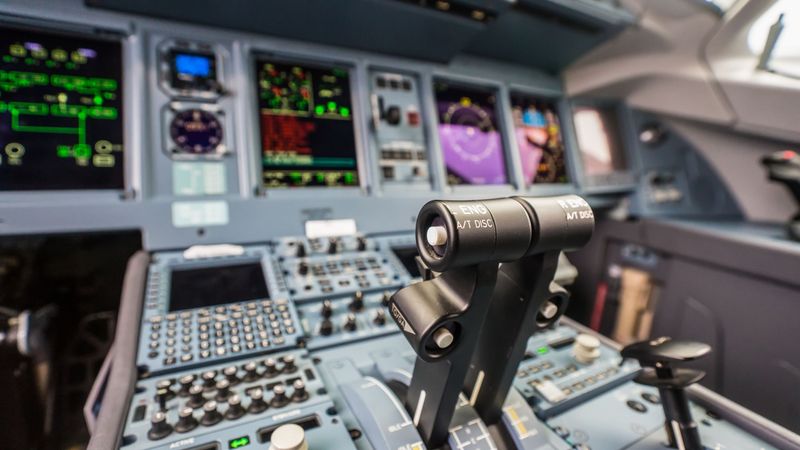Case Studies in Managing Avionics Component Obsolescence
Futureproofing Aerospace Series. Article #6. These real-world examples show how to manage component obsolescence for avionics designs effectively.
Stay at the cutting edge of the aerospace industry
We are pleased to have partnered with Rochester Electronics to launch the Future-Proofing Aerospace whitepaper.
Whitepaper highlights:
- Understand the Importance of Legacy Systems: Discover why preserving legacy avionics systems is crucial for reliability, compliance, and cost-effectiveness.
- Navigate Component Obsolescence: Learn about the challenges aerospace designers face due to outdated or discontinued components and how to address them.
- Explore Solutions from Rochester Electronics: Gain insights into how Rochester Electronics specializes in preserving and replicating obsolete components to ensure the continued operation of legacy systems.

Solving component obsolescence challenges
Dealing with component obsolescence is one of the most challenging obstacles an avionics designer may encounter. In the previous installments of this article series, we discussed the impact and causes of component obsolescence, as well as practical techniques and resources to help navigate the complexities of obsolete components. In this piece, we’re going to look at some real-world examples of companies that worked alongside Rochester Electronics to solve their component obsolescence challenges.
Military aviation
Rochester Electronics faced a challenging situation when approached by a manufacturer of engine control modules for the United States Military regarding field failures in aircraft engine control modules[1]. These failures were traced back to counterfeit microprocessors, which a manufacturer had procured from a grey market source instead of purchasing authorized devices. This decision, initially made to reduce costs, led to a series of failures and malfunctions in aviation equipment.
As failures mounted, the gravity of the situation became clear. Military aircraft were at risk, and the lives of service members were at risk. Meanwhile, the manufacturer found itself facing costly recalls and substantial fines. The initial cost savings quickly evaporated in the face of these unforeseen expenses and the potential for even more severe consequences.
The original components' obsolescence compounded the problem. The original manufacturer no longer had the necessary test protocols for these outdated devices, making it challenging to prove the components were counterfeit definitively.
Rochester’s role in resolving this obsolescence challenge was multifaceted. As a 100% authorized and licensed partner, Rochester possessed the necessary test IP to prove the components were counterfeit conclusively. It then supplied the manufacturer with authorized, licensed devices that performed flawlessly in the field and met the stringent safety requirements of military aviation. Rochester Electronics’ components eliminated the need for time-consuming redesign or requalification processes, allowing for a swift resolution to the crisis.
Rochester Electronics takes pride in its 100% certified, authorized, and licensed manufacturing processes. All its components are guaranteed and sold under the original manufacturer's part number, giving customers confidence in their authenticity and reliability. Additionally, it offers ISO-9001, AS9120, and (QML) MIL-PRF-38535 certifications and QSLD qualification.
Avionic Flash Memory
A major global aerospace manufacturer faced a dilemma when they learned that the NAND flash memory device for their avionics systems was being discontinued by the Original Component Manufacturer (OCM)[2]. The situation presented a potential crisis, as replacing the component proved far from straightforward.
The manufacturer needed to find a form, fit, and functional replacement that could utilize the available die while replicating the multi-die package required for their product. They were keen to avoid the substantial expenses associated with a last-time buy (LTB), the carrying costs of stocking the product, and, most importantly, a costly redesign of their systems.
Rochester Electronics proved uniquely positioned to address this challenge. With their extensive experience in component replication and strong relationships with OCMs, they were able to offer a comprehensive solution.
The company's in-house team, working with full OCM approval, successfully reverse-engineered the package. This meticulous process allowed Rochester to provide authorized components that were 100% form, fit, and functionally equivalent to the original. Importantly, this meant no software changes were required, saving the manufacturer from a time-consuming and expensive DO-254 recertification process.
Through this process, Rochester also ensured the customer had a continuous, authorized supply of these components for the next 7-10 years and beyond. Their long-term solution ultimately eliminated the need for the manufacturer to make a large last-time buy or incur ongoing inventory-carrying costs.
Military hybrid Modules
Our final case study comes from a client of Rochester’s, an aerospace and defense technology company that needed to guarantee a continuous supply of custom electronic hybrid modules for long-life military applications[3]. These hybrid modules were considerably complex, consisting of multiple semiconductor components, passives, and hermetically sealed substrate packages.
Specifically, the company required a custom military hybrid module initially designed in the 1970s. Unsurprisingly, the original equipment manufacturer (OEM) no longer supported new builds, and the necessary active semiconductor components were unavailable on the open market. This situation threatened the continuity of specific military programs and posed a risk of costly redesigns, development, testing, and re-qualification.
Seeking a solution, the company approached Rochester Electronics for specialized assembly services. They needed a partner capable of providing high-frequency assembly and test support based onshore in the United States and with full ITAR compliance, and Rochester fit the bill.
Rochester’s extensive capabilities in supporting long-life military applications, coupled with their US-based manufacturing facilities and ITAR registration, made them uniquely qualified to tackle the problem. For example, their 60,000-square-foot Newburyport, Massachusetts, facilities were perfectly equipped to handle the hermetic assembly services required for this project.
The project progressed through detailed reviews and a prototype phase, where 100 units of prototype hardware successfully passed qualification and met all program requirements. These prototypes had to meet numerous technical specifications, including specialized substrate and chip attachments, wire bonding, hermetic sealing, and rigorous testing protocols.
The hybrid module assembly has since moved into full production, with over 3,000 parts delivered to date.
Solving Component Obsolescence
Rochester Electronics has been helping customers understand, navigate, and solve their avionics component obsolescence challenges for decades. Like the companies demonstrated in these case studies, your team can rely on Rochester to help resolve any obstacles associated with obsolete components.
Learn more about solving their component obsolescence challenges in the latest whitepaper from Rochester.
Read more in the series:
Article 1: The Importance of Preserving Legacy Systems in Avionics
Article 2: The Causes of Component Obsolescence
Article 3: Customer Challenges with Obsolete Components
Article 4: Solving Obsolescence with Rochester Electronics
Article 5: Proactive Strategies for Managing Avionics Obsolescence
References
[1] https://rocelec.widen.net/s/vv6kzd5mql/military_aviation_case_study_safetyfirst
[2] https://rocelec.widen.net/s/qjm2pdrqzv/aerospace-_case-study
[3] https://rocelec.widen.net/s/bcwcdtgtmw/hybrid-module-assembly_case-study

